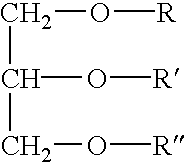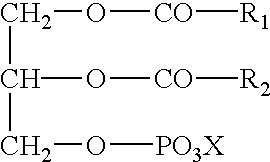Polymerizable fatty acids, phospholipids and polymerized liposomes therefrom
a technology of polymerizable fatty acids and phospholipids, which is applied in the field of new drugs, can solve the problems of low absorbability, inability to effectively induce mucosal immune responses, and poor adsorption and stability of drugs, and achieve enhanced stability in the g-i tract, improved ability to target specific cells, and improved the effect of sensitivity
- Summary
- Abstract
- Description
- Claims
- Application Information
AI Technical Summary
Benefits of technology
Problems solved by technology
Method used
Image
Examples
example 1
5. EXAMPLE 1
(A) Synthesis of 2,4-ODPEG
2,4-ODPEG was synthesized as follows. 50 mg of 2,4-octadecadienoic acid (2,4-OD) was dissolved in 5 ml of N,N-dimethylformamide (DMF) under inert gas (argon), with constant stirring. 1.78 g of polyethylene glycol (average molecular weight of 400) and 217 mg of dimethylaminopyridine (DMAP) were added. Then 410 mg of 1-ethyl-3-(3-dimethylaminopropyl)carbodiimide HCl (EDCl) was added, and the solution stirred at room temperature for 24 hours. The reagent vessel was kept wrapped in aluminum foil during this time, to protect against UV degradation. The reaction was then quenched by the addition of a few milliliters of ice water, to destroy remaining EDCl. DMF and water were then evaporated under vacuum.
The compound thus obtained was purified in two stages. First, it was purified by dialysis against distilled water (500 ml) in a Spectraphor.RTM. dialysis tube (MWCO 500). The dialysis procedure was repeated a total of four times. The solution was evapo...
example 2
6. EXAMPLE 2
COUPLING OF 2.4-ODPEGSu WITH EEA
A polymerizable fatty acid was coupled to a lectin, and the degree of lectin modification determined, according to the following method.
6.1. MATERIALS AND METHODS
COUPLING OF 2.4-ODPEGSu WITH EEA
EEA was coupled to 2,4-ODPEGSu by the following method. 0.5 mg of 2,4-ODPEGSu was dissolved in 0.6 ml of a pH 5.4 MES buffer (2-(N-morpholino)ethane-sulfonic acid, sodium salt) (Aldrich). 3 mg of N-octylglucoside, 5 mg of EDCl, and 11.5 mg of N-hydroxylsulfosuccinimide (NHS) were added. The reaction was run at room temperature for 5 minutes, with constant stirring. Next, 1.46 mg of EEA in a phosphate buffered saline (PBS) solution, and 0.5 ml of 1 molar HEPES buffer were added. The pH of the solution was adjusted to 7.6, and the solution was stirred at 4.degree. C. overnight. The product was dialyzed against 0.2 mM PBS (300 ml.times.5) in a Spectra Por dialysis tube (MWCO=2,000) for a total of 30 hours. The purified product was transferred to a vial...
example 3
7. EXAMPLE 3
POLYMERIZABLE LIPOSOMES INCORPORATING MEMBRANE PROTEINS
DODPC is dissolved in octylglucoside, and the desired peptide is dissolved in PBS. The peptide solution is then added to the lipid inside of a dialysis membrane (MWCO=10,000) and dialyzed versus PBS (2 ml versus 1 liter) for approximately four hours, with two changes of PBS. The liposomes spontaneously form in the dialysis membrane. The liposomes thus formed can be polymerized using a redox couple initiator (e.g., NaHSO.sub.3 and K.sub.2 S.sub.2 O.sub.8).
PUM
| Property | Measurement | Unit |
|---|---|---|
| diameter | aaaaa | aaaaa |
| diameter | aaaaa | aaaaa |
| degree of polymerization | aaaaa | aaaaa |
Abstract
Description
Claims
Application Information
 Login to View More
Login to View More - R&D
- Intellectual Property
- Life Sciences
- Materials
- Tech Scout
- Unparalleled Data Quality
- Higher Quality Content
- 60% Fewer Hallucinations
Browse by: Latest US Patents, China's latest patents, Technical Efficacy Thesaurus, Application Domain, Technology Topic, Popular Technical Reports.
© 2025 PatSnap. All rights reserved.Legal|Privacy policy|Modern Slavery Act Transparency Statement|Sitemap|About US| Contact US: help@patsnap.com



